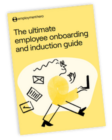How to perform a cost-benefit analysis of hiring
Deciding when to hire and how to build a business case for further recruitment

Need to increase headcount but struggling to get the green light from your senior decision makers?
It can be tricky to convince the higher-ups that investing money in more employees is necessary. But the reality is that being understaffed is bad for business. If work isn’t completed in a timely manner, the business is losing money. On top of this, it can result in employees being overworked, feeling under appreciated and lower employee morale.
But as a small business owner, or HR professional, it can be hard to know when the right time to hire is. And how do you determine which team needs new members the most?
This is where a cost-benefit analysis might come in handy. This is a process you can use to build your business case and get the all important sign off to add employees to your payroll.
An audit such as this can also get clarity on what skill set your business really needs, and at what seniority level. It allows you to consider the pros and cons of hiring and makes it easy for the leadership team or major shareholders to understand and give the final sign off.
If you want to learn more about how to conduct a cost-benefit analysis, keep reading.
What is a cost-benefit analysis in HR?
A cost-benefit analysis or CBA is an approach used to estimate the strengths and weaknesses of a potential decision. It looks at the advantages, or benefits, and the disadvantages, or costs, associated with a decision, project or policy. The goal of this type of audit is to help determine if a suggestion should be taken forward or rejected.
When it comes to HR and hiring, a cost-benefit analysis looks at recruitment from cost to value perspective. For example, how much will the hiring process, and a new staff member cost, vs how much value will that position bring to the company. It can be used in an overarching business case for making new hires or establishing a new programme such as an apprenticeship or graduate scheme.
Essentially, you’re looking to calculate the total cost of the investment to compare against the predicted return.
But be warned – this isn’t as easy as it sounds. Costs and benefits can be direct and indirect, tangible and intangible, meaning they can be very hard to quantify.
Hiring costs
Hiring is an expensive process. There are a number of direct and indirect fees which must be taken into consideration, and thinking about these is an important element of a hiring audit analysis.
Some of the primary costs involved in hiring include:
- Recruiting costs e.g. advertising and agency fees
- Training costs of a new hire, including lost production time during training, and hours invested by team members
- Wages, including benefits such as health insurance, and pensions
- Overhead costs, including office space, equipment, technology and subscriptions
Hiring benefits
A large part of a cost-benefit analysis for recruitment involves looking at the advantages of hiring.
For the purpose of an audit, it is important to consider the tangible advantages, rather than intangible. While this is complex when it comes to roles and personnel, the better you can quantify in terms of a monetary value, the clearer the cost-benefit analysis will be.
Benefits include:
- Income generation
- Increased productivity and efficiency leading to increased revenue
- The benefits associated with easing team workload, such as reduced staff turnover, reduced absenteeism, reduced stress, improved engagement and culture
- Improved customer satisfaction / reduced churn
- Improved team culture
- Capacity to grow the team and company
- Reduced freelancer costs
- Reduced overtime costs
Another way to consider the advantages of hiring staff is to look at the flipside – the drawbacks of not hiring more staff. These can be considerable, and might even swing a decision from senior management. Examples include:
- Unfinished or overrunning projects
- Reduced work quality
- Loss of revenue
- Customer complaints
- Legal claims against the business
- Negative PR
- Overworked staff, potentially leading to increased rate of injury
- Staff absenteeism
- Higher levels of burnout
- Low staff morale
Why should you conduct a cost-benefit analysis?
Conducting cost-benefit analyses can aid swift decisions when it comes to hiring. Presenting a considered audit surrounding the advantages of hiring, and framing decisions in terms of monetary value, makes it easier to demonstrate the business case for additional personnel, or what return on investment a new role or program could bring.
It can also be used to compare other choices, such as whether a different hire might be a better investment, or it could help prove the case for further team training, wellbeing programmes, or employee engagement efforts. Or, getting even more strategic, an audit might reveal how a new HR system might give you an even better return on investment.
What are the types of cost-benefit analysis?
There are different ways to conduct a hiring audit, and the technique you use will depend on what objective you’re trying to meet in bringing in your hire, and how you’ll measure whether the cons outweigh the pros.
A very familiar term when analysing costs is ‘return on investment.’ Return on investment (ROI) is a calculation based on tangible numbers such as sales or revenue, conversions, and, of course, the new employee’s salary.
However, a cost-benefit analysis can also be more complex, allowing you to balance intangible considerations and provide a wider context to use when making decisions.
So let’s take a look at three of the most common types of cost-benefit analysis.
1. Payback period
Payback period is one of the most popular types of audit because it gives a very clear and easy to understand output. The formal definition of a payback period is the number of years required to recover the original cash investment. Usually this is calculated for capital investments such as machines or equipment, but it can also be useful to calculate the payback period of a senior hire, or investment in a specific team or business strategy via a new hire or program. You’re looking for how long it will take for that strategic hire to produce sufficient revenue to justify or recover the investment costs.
2. Net present value
Net present value (NPV) is the difference between the present value of cash inflows and the present value of cash outflows over a period of time. NPV is used in capital budgeting and investment planning to analyse the profitability of a projected investment or project, which could be a very useful number to present to senior management when you’re looking to justify a new hire.
3. Rate of return
A rate of return (RoR) is the net gain or loss of an investment over a specified time period, expressed as a percentage of the investment’s initial cost. Unlike ROI which is a simple percentage, the rate of return is framed by time, linking your return to a specific timeframe. This might be particularly useful if you’re considering a time-limited role or program, such as a six-month internship.
Six steps in the cost-benefit analysis process
1. Identify the relevant company objectives (OKRs)
The first step is to look at what objective you’re trying to meet. For example, it could be about increasing revenue, and you have a specific key result to increase conversions by 10% to increase revenue. Being clear about the objective and key result will help you stay focused when analysing the relevancy or weight of the costs and benefits associated with the hire.
2. Audit workload
The next stage is to audit your current workload to understand how much work is being done in your team, how much time is being spent on specific tasks, and where the bottlenecks or opportunities lie.
This will give an indication as to if your team is overstretched and can show where a new hire could help – but remember the gaps might not always be where you think they are.
3. Define requirements (by role or by team)
Once you’ve gathered information on team needs, you can start to build the role. This stage presents you with an opportunity to creatively address the issue by reallocating existing resources and responsibilities before you start to define new ones. This is important because this is where you’ll start to get an idea of a budget for the role – you’ll use this later to analyse the costs and benefits.
4. Weigh up costs and benefits
Then it’s time to quantify the indirect and direct costs and benefits – see above for our guidance, or develop your own specific to your business. Each cost and benefit needs to be assigned a monetary value so that you can input it into your calculation.
5. Consider alternatives
While you’re looking at the pros and cons of an action, it’s important to consider if there are other ways to achieve the objective. For example, do you need a new full time member of the team, or would a part time member suffice? It’s also worth looking at the resources you currently have and seeing if they can be reallocated – could a current member of the team switch roles, or is there software that can automate processes to reduce manual work?
6. Use results to build a business case
After considering all the options, cost-benefit analysis can be performed on the chosen course of action. From here, you can build a business case for your request. This could include sourcing new talent or establishing a new graduate programme.
Using the results of cost-benefit analysis to make an informed decision
Conducting a cost-benefit analysis is only part of your strategy when making an informed decision. You might also take into account anecdotal evidence that comes up through regular 1:1 meetings with your team. The wider context can be considered in a business case which can help convince senior leadership to sign off your request.
Mapping out tasks and activities that your team regularly carries out is a significant part of the decision making process. Having a good understanding of the workload and the time required helps clarify exactly what is needed, and also guides the seniority level required.
This also helps you understand the budget requirements. As an alternative, you might start with a budget in mind in order to identify how many roles you have the capacity for in your business.
Whether your team is struggling to deliver on workloads or lacks strategic direction to grow with the business, mapping tasks and budgets can help build the business case for a new role or even a new team or department.
When making an informed decision, use the findings of the audit and business case to think about:
- How many people you want to hire
- What you want them to do
- What experience or skill set they need to have
- What level of responsibility they will have
- What their main responsibilities will be
- What the salary (bands) will be
- Where they will fit in the company objectives
- How else these objectives could be met
The wrap up
Figuring out what you need in terms of resources and understanding the budget is perhaps the most important part of building the business case, and will also shape the cost-benefit analysis for hiring. When you’re conducting an audit for hiring a new employee, assigning monetary values to help calculate if the benefits outweigh the costs is incredibly useful.
Whilst this process is designed to establish if there is a need for a new hire, or not, it can also be helpful in the hiring process. By the time you get to advertising for the role, you will have a clear understanding of what skillset you are looking for and what level of seniority you need in your team.
Thinking about hiring?
Get our comprehensive, no nonsense guide to recruitment.
Hiring can be a time consuming and expensive process, so why not simplify it with Employment Hero’s SmartMatch? The Employment Hero platform can help you find and hire top talent, as well as seamlessly onboard any new hires. Our all in one platform streamlines business processes through automating complex payroll and driving employee engagement. This means you can spend less time on admin, and focus on what really matters – your people.
Learn more by speaking to one of our team today.
Related Resources
-
 Read more: Employment Rights Bill Timeline: Key Dates for Employers
Read more: Employment Rights Bill Timeline: Key Dates for EmployersEmployment Rights Bill Timeline: Key Dates for Employers
The UK Employment Rights Bill is coming. Discover the key dates from 2026 to 2027, and learn how to prepare…
-
 Read more: 7 common types of leadership styles and how to find yours
Read more: 7 common types of leadership styles and how to find yours7 common types of leadership styles and how to find yours
Learn the 7 most common types of leadership styles, their strengths and how to identify your own – with guidance…
-
 Read more: Unauthorised Absence From Work: A Complete Guide
Read more: Unauthorised Absence From Work: A Complete GuideUnauthorised Absence From Work: A Complete Guide
Absences that aren’t authorised can disrupt productivity & morale. Learn to manage them effectively, comply with employment law & prevent…












